Exploring Snowdrop Varieties With Jane Rowlinson, Galanthus Grower At Morlas Plants

Reviewed By PETER LICKORISH

Peter is a Horticulture Lecturer and self-employed Horticulturist, with a passion for diverse areas of the industry - from garden design to the science behind plant growth and propagation. He has completed the Royal Horticultural Society’s Master of Horticulture (MHort) Award and lectures on RHS courses at Bedford College.
Contributions From JANE ROWLINSON

Jane is the Owner of Morlas Plants, an online plant nursery that specialises in Galanthus and other bulbous plants. Jane has been growing snowdrops for over 25 years. Her nursery is home to over 500 different varieties of Galanthus.
IN THIS GUIDE
- Nursery Varieties
- 1) G. nivalis
- 2) G. nivalis ‘Anglesey Abbey’
- 3) G. ‘S. Arnott’
- 4) G. nivalis ‘Alan’s Treat’
- 5) G. nivalis f. pleniflorus ‘Pusey Green Tips’
- 6) G. nivalis ‘Sandersii Group’
- 7) G. nivalis ‘Scharlockii’
- 8) G. nivalis ‘Virescens’
- 9) G. nivalis ‘Green Tear’
- 10) G. nivalis f. pleniflorus ‘Flore Pleno’
- 11) G. nivalis f. pleniflorus ‘Bagpuize Virginia’
- 12) G. ‘Atkinsii’
- 13) G. elwesii
- 14) G. elwesii ‘Mary Biddulph’
- 15) G. elwesii ‘Ransom’s Dwarf’
- 16) G. elwesii (Hiemalis Group)
- 17) G. elwesii ‘Polar Bear’
- References
GALANTHUS GUIDES
Sowing
Varieties
Snowdrops produce bashful little bells that emerge from the snowy ground by February and nod their three-petalled snowy white blooms from arching stems.
A light, fresh fragrance tops off snowdrops’ delicate charms.
Snowdrop bulbs are something of a collector’s item, particularly in the UK.
Interestingly, the UK is only an adopted home to Galanthus plants, which were naturalised in the British Isles several centuries ago.1Snowdrop. (n.d.). PlantAtlas. Retrieved March 16, 2023, from https://plantatlas2020.org/atlas/2cd4p9h.ymh
“Snowdrops are one of those plants people love to collect,” shares Master Horticulturist Peter Lickorish.
“Their intricate variations captivate many growers to continually seek out new varieties.
Avid lovers of snowdrops may pay almost a couple of thousand pounds for a single bulb of a choice new cultivar.
“I personally find they look more natural if just one variety is selected for each area of the garden, such as one cultivar for around the base of a tree, and a different one to drift through a border.”
Nursery Varieties
We asked Jane Rowlinson, specialist Galanthus grower from Morlas Plants, about some of her favourite snowdrop varieties – and she had lots to share with us.
“My favourite yellow snowdrop is Galanthus ‘Primrose Warburg’, as it is very easy to grow and has a nice blueish tinge to the leaves.
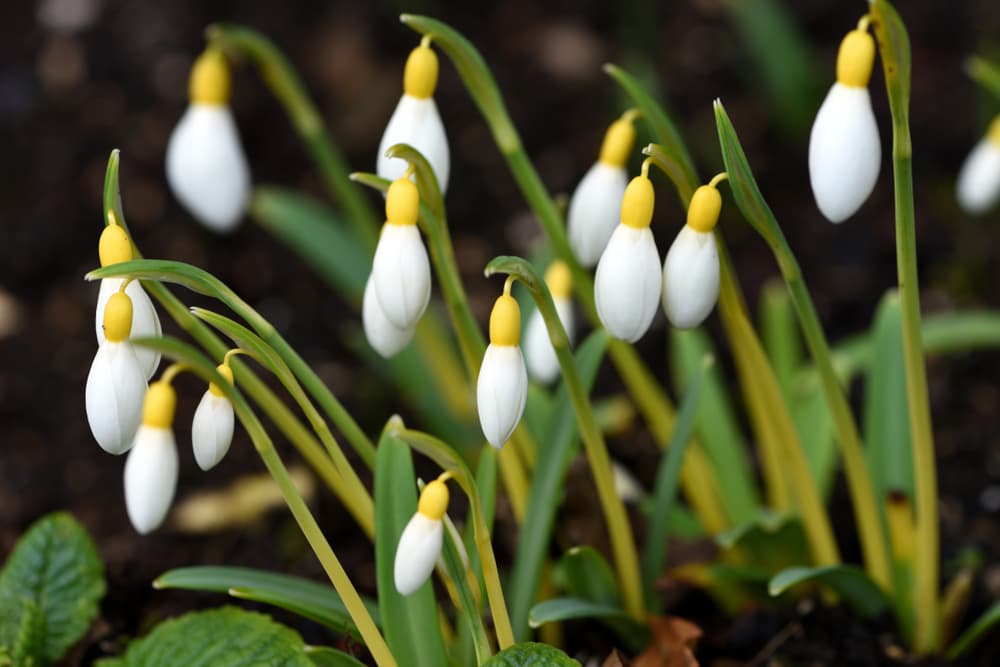
“When grown in large swathes in a sunny spot it produces a stunning display.
“Galanthus ‘Trumps’ is the best of the green-tipped cultivars. A very quick grower, it looks fabulous planted amongst red-stemmed cornus plants.
“The best double for me has to be G. ‘White Swan’, a tall elegant growing snowdrop that is easy to grow and was the first rare snowdrop I had in my collection.
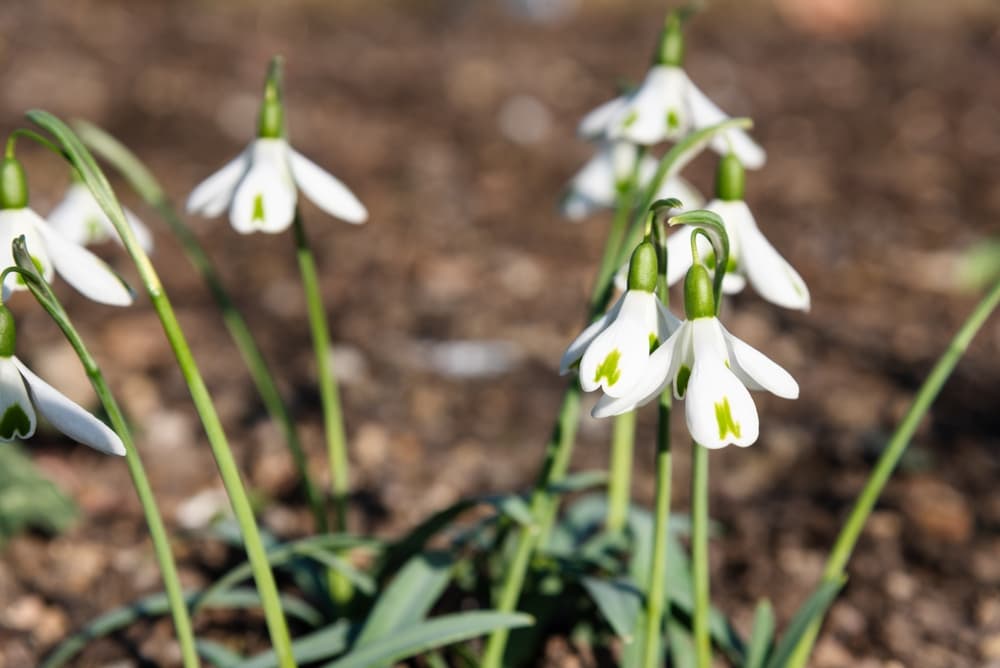
“Although the named cultivars are nice to grow, you still cannot beat G. nivalis for making white carpets in a garden or woodland setting.
“Inexpensive to buy and easy to grow, every garden in the UK should have at least one clump of them to help the bees and to bring a spot of cheer during the winter months.”
Peter also shares his favourite varieties to grow:
“If you just cannot wait for snow until you see snowdrops, G. reginae-olgae is an autumn flowering cultivar, which can start blooming as early as September.
“Some cultivars, such as G. ‘S. Arnott’ make good cut flowers, where their honey-like fragrance can be enjoyed for a long period in a small vase.”
Below, I share seventeen of my favourite snowdrop varieties for you to hunt down and grow.
All of the varieties listed below are H5 hardy (suited for all areas of Britain) and can be grown in an exposed area with any soil type.
1) G. nivalis
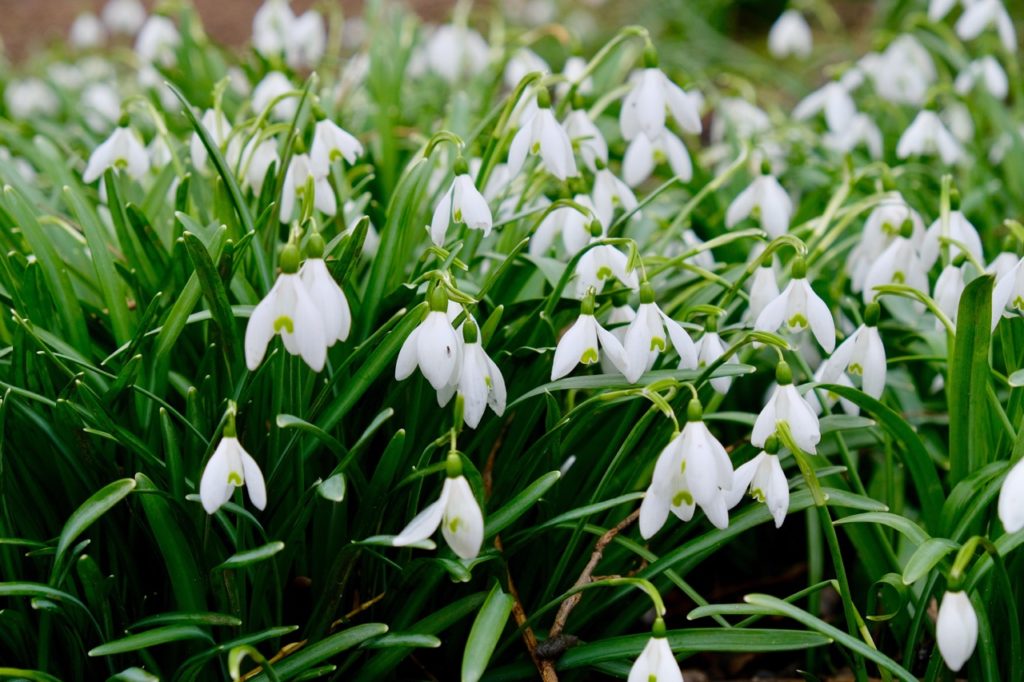
- COMMON NAME(S): common snowdrop
- FLOWERING SEASON(S): winter
- SUNLIGHT: partial shade
- SIZE: 0.1-0.5m in height, 0-0.1m spread
As it happens, the species plant is one of the least showy in its genus, growing to around 12-15cm tall with drooping flowers that are around 2.5cm in length.
What’s more, the inner tepals have green markings at the tip.
The common snowdrop is one of the first snowdrops to appear and can bloom from as early as January.
This plant has received the RHS Award of Garden Merit.
2) G. nivalis ‘Anglesey Abbey’
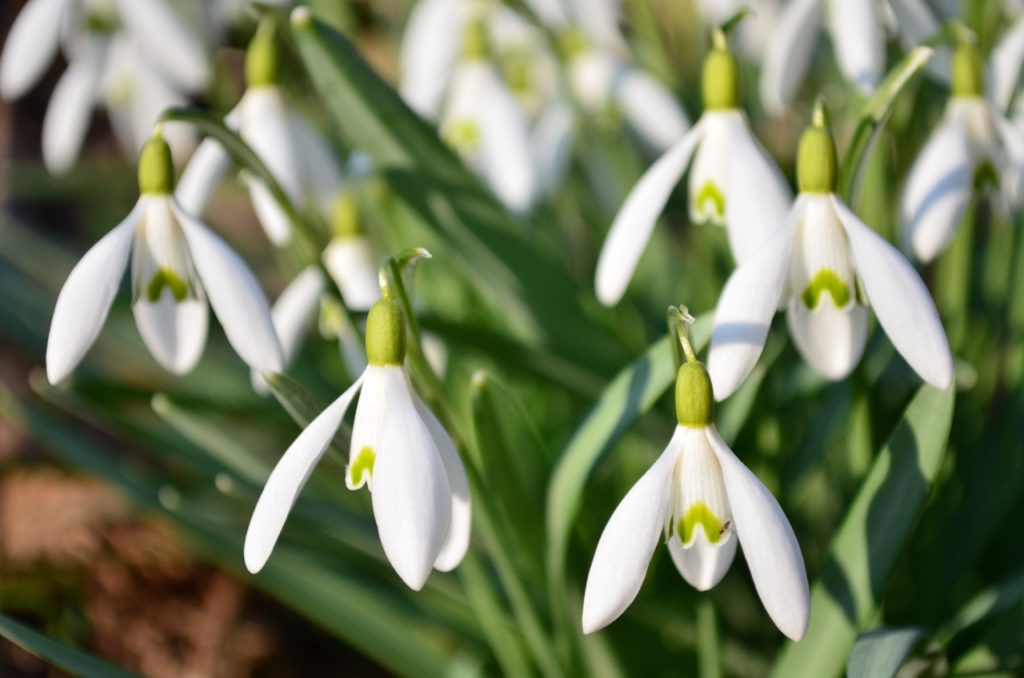
- COMMON NAME(S): snowdrop ‘anglesey abbey’
- FLOWERING SEASON(S): winter
- SUNLIGHT: partial shade
- SIZE: 0.1-0.5m in height, 0-0.1m spread
Perhaps no other variety is as likely to produce a pure-white flower as ‘Angelsey Abbey’.
This cultivar is similar to the species in every respect, except that on some plants, all flowers may be entirely white, wholly skipping the green markings.
“Where this occurs, and the inner tepals almost match the outer length, this is known as a poculiform snowdrop,” explains Peter.
3) G. ‘S. Arnott’
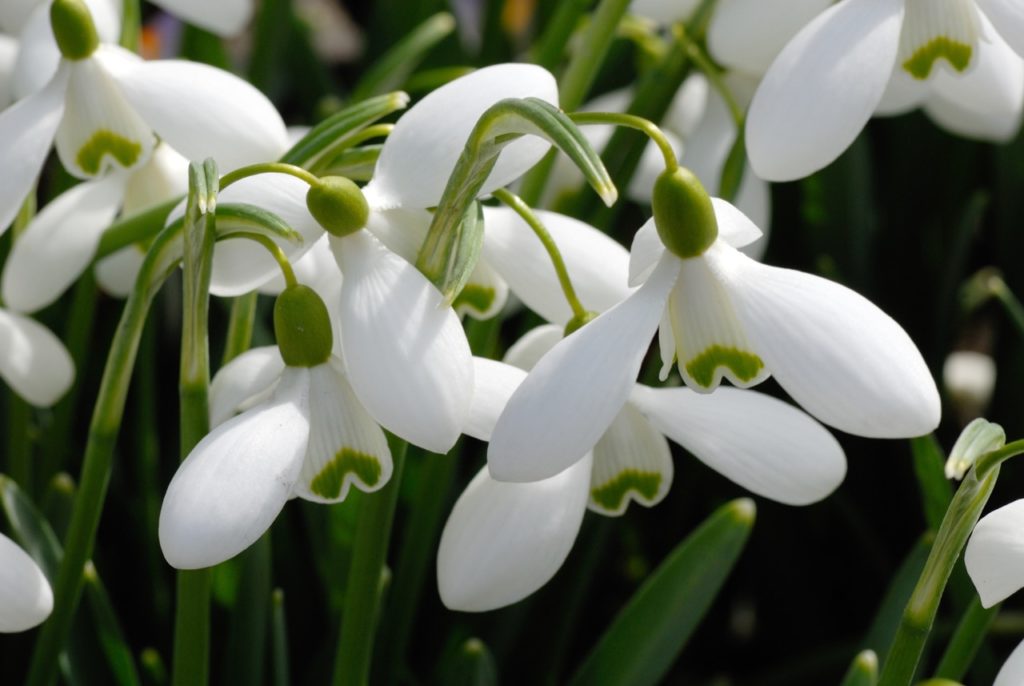
- COMMON NAME(S): snowdrop ‘s. arnott’
- FLOWERING SEASON(S): winter
- SUNLIGHT: partial shade
- SIZE: 0.1-0.5m in height, 0-0.1m spread
Very similar in many respects to the mother plant, ’S. Arnott’ features flowers that eventually open out almost fully, looking quite like tiny propellors aimed downward.
The inner tepals have a mark like an inverted ‘V’, which often comes in a brilliant shade of green.
This variety is another recipient of the RHS Award of Garden Merit.
4) G. nivalis ‘Alan’s Treat’
- COMMON NAME(S): snowdrop ‘alan’s treat’
- FLOWERING SEASON(S): winter / spring
- SUNLIGHT: full sun / partial shade
- SIZE: 0.1-0.5m in height, 0.1-0.5m spread
Producing more of a half-open than half-closed look, ‘Alan’s Treat’ has pale green, smudge-like markings on the outer sides of the tepals and very prominently so on the outer ones.
It has unusually long inner tepals and can rise up to 15cm tall.
These delightful flowers emerge in February.
It too can have a poculiform flower.
5) G. nivalis f. pleniflorus ‘Pusey Green Tips’
- COMMON NAME(S): snowdrop ‘pusey green tips’
- FLOWERING SEASON(S): winter
- SUNLIGHT: full sun / partial shade
- SIZE: 0-0.1m in height, 0-0.1m spread
Among the most diminutive of snowdrops, ‘Pusey Green Tips’ reaches no more than 10cm in height.
Much like ‘Alan’s Treat’, it too exhibits that half-open look.
Its flowers have a pronounced, virtually vertical droop, and all 6 tepals have fairly bright green spot-like markings near the tips.
6) G. nivalis ‘Sandersii Group’
- COMMON NAME(S): snowdrop sandersii group
- FLOWERING SEASON(S): winter
- SUNLIGHT: full sun / partial shade
- SIZE: 0.1-0.5m in height, 0.1-0.5m spread
Also dubbed yellow snowdrops, these flowers are often tinged yellow at the point where the stem meets the flower.
They also have distinct yellow markings near the tips of the inner tepals.
Since this variety opens up a little more than usual, the yellow-marked inner tepals are often visible.
It can reach 15cm tall and is one of the early bloomers.
7) G. nivalis ‘Scharlockii’
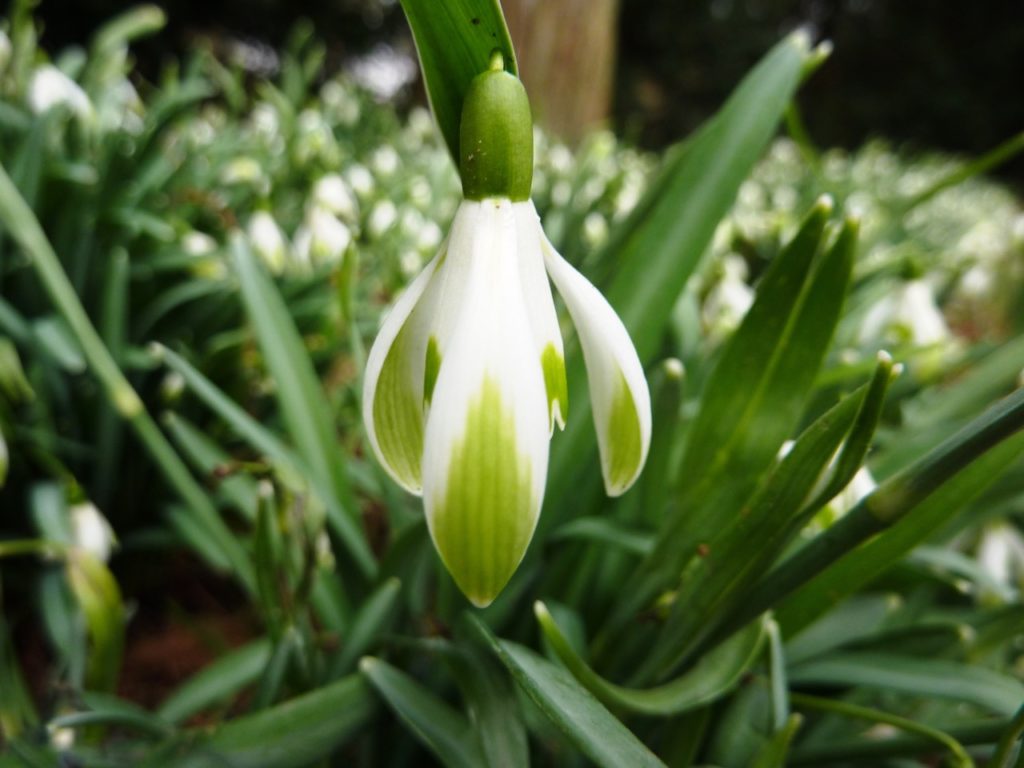
- COMMON NAME(S): snowdrop scharlockii group
- FLOWERING SEASON(S): winter
- SUNLIGHT: partial shade
- SIZE: 0.1-0.5m in height, 0-0.1m spread
This cultivar has a special feature because the pendent bells of ‘Scharlockii’ droop from a fairly long split spathe, meaning the flowers nod from in-between two green horns.
The outer tepals have highly variable markings, from delicate shading in pale green to an inverted ‘V’ in mid-green.
The inner ones, however, bear consistent green marks at the tip.
8) G. nivalis ‘Virescens’
- COMMON NAME(S): snowdrop ‘virescens’
- FLOWERING SEASON(S): winter
- SUNLIGHT: full sun / partial shade
- SIZE: 0.1-0.5m in height, 0.1-0.5m spread
A cultivar that is fairly standard in respect to its size, season and floral form, ‘Virescens’ features the most unusual and delightful floral colourings.
Each outer tepal carries a long and thick prominent mark quite like a brushstroke in shaded pastel green while the inner tepals are solid deep green with a narrow white border.
9) G. nivalis ‘Green Tear’
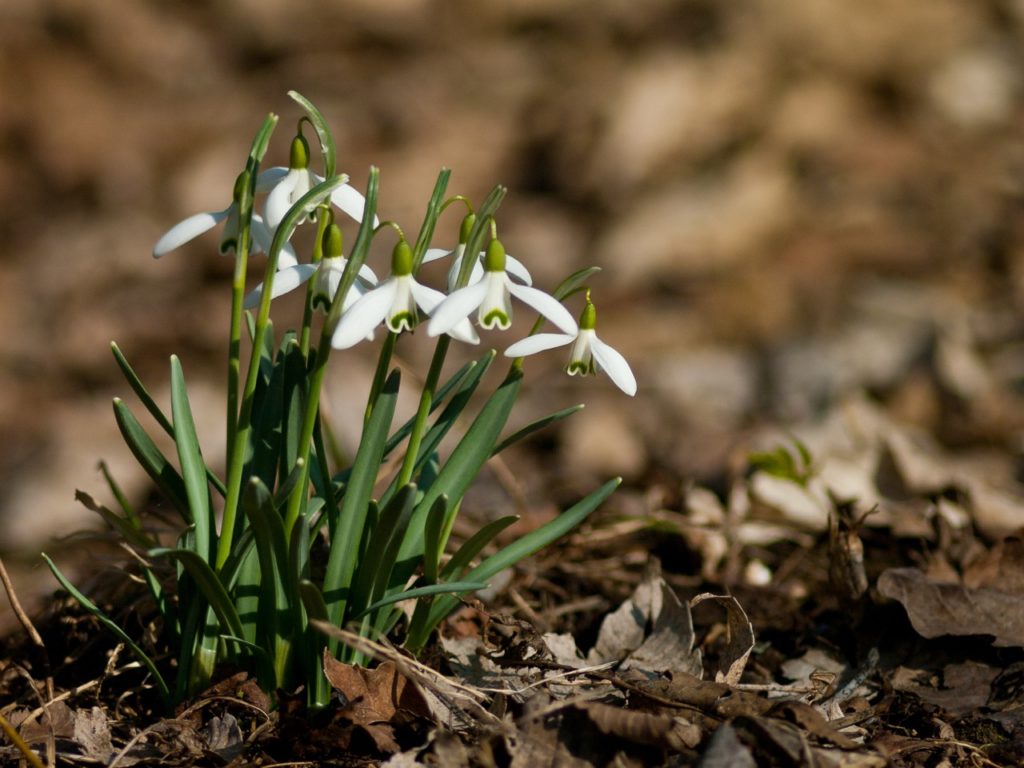
- COMMON NAME(S): snowdrop ‘green tear’
- FLOWERING SEASON(S): winter / spring
- SUNLIGHT: full sun / partial shade
- SIZE: 0.1-0.5m in height, 0.1-0.5m spread
‘Green Tear’ has its own claim to fame.
First, though, this cultivar properly welcomes spring as it does not precede the season but rather ushers it in.
The outer tepals have a streaky smudge in pale green while the inner ones bear more solid, deep green marks that may cover nearly the entire surface.
What makes this variety special is that quite often two bells will dangle from each stalk.
10) G. nivalis f. pleniflorus ‘Flore Pleno’

- COMMON NAME(S): double snowdrop
- FLOWERING SEASON(S): winter
- SUNLIGHT: full sun / partial shade
- SIZE: 0-0.1m in height, 0-0.1m spread
A popular and sought-after double-form variety, ‘Flore Pleno’ is distinguished by several sets of inner tepals that look rather like frilly skirts.
These ‘skirts’ are decorated with streaky smudges of green, sometimes further adorned with yellow or orange markings.
Though the dimensions of the plant and flower are similar to other cultivars, it is the form and colour of the flower, an especially fragrant one, that makes this cultivar so special.
This variety has received the RHS Award of Garden Merit.
11) G. nivalis f. pleniflorus ‘Bagpuize Virginia’
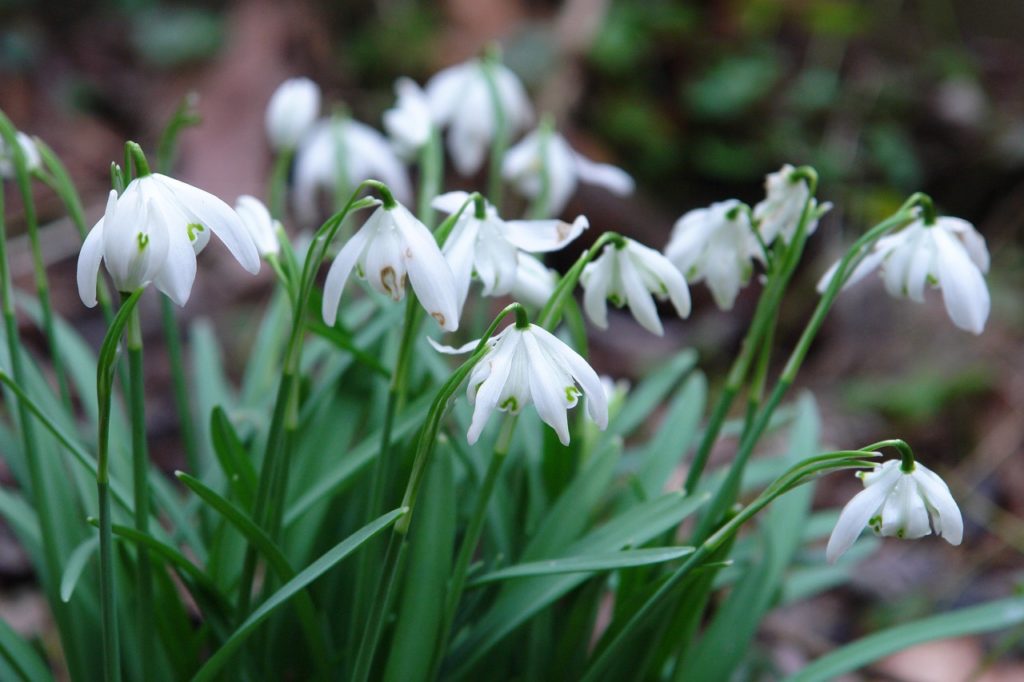
- COMMON NAME(S): double snowdrop ‘bagpuize virginia’
- FLOWERING SEASON(S): winter
- SUNLIGHT: full sun / partial shade
- SIZE: 0.1-0.5m in height, 0.1-0.5m spread
More difficult to source than ‘Flore Pleno’ is another double form – ‘Bagpuize Virginia’.
This big variety can reach 20cm tall.
The inner tepals have double layers with notches and are marked with a bright green inverted ‘V’, while the outer ones are more discreetly marked with green spots.
12) G. ‘Atkinsii’
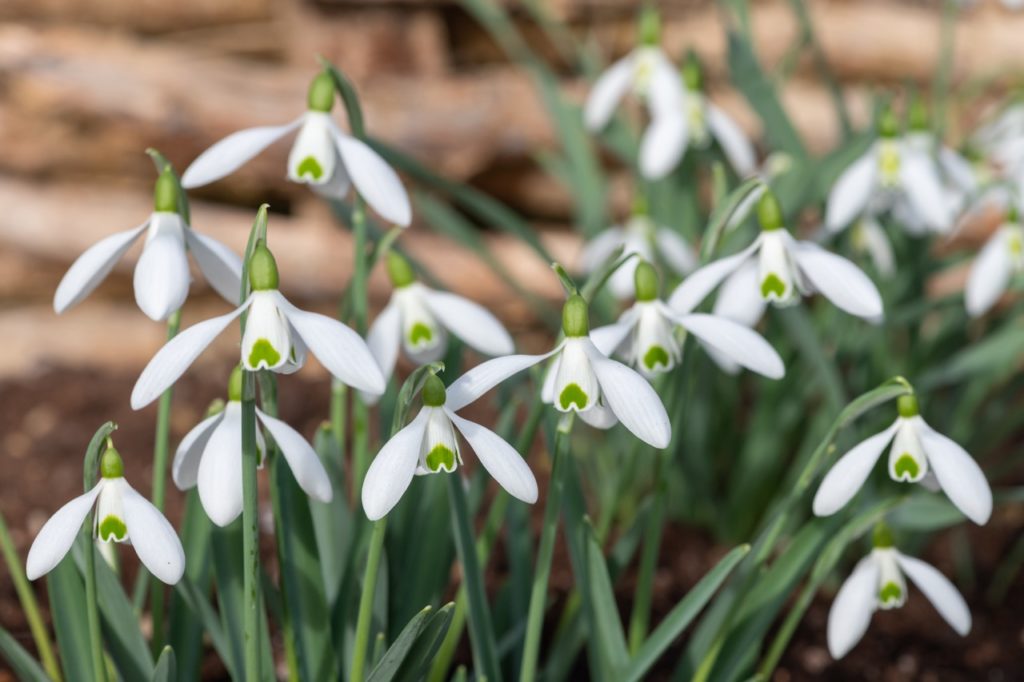
- COMMON NAME(S): snowdrop ‘atkinsii’
- FLOWERING SEASON(S): winter
- SUNLIGHT: partial shade
- SIZE: 0.1-0.5m in height, 0-0.1m spread
Breaking the mould for snowdrops, ‘Atkinsii’ can reach a commanding height of up to 25cm!
Matching its height, its flowers’ tepals have a plumper appearance than those of other cultivars. The outer tepals are pure white; the inner ones display a conspicuous inverted green heart.
Unsurprisingly, this is another recipient of the RHS Award of Garden Merit.
13) G. elwesii
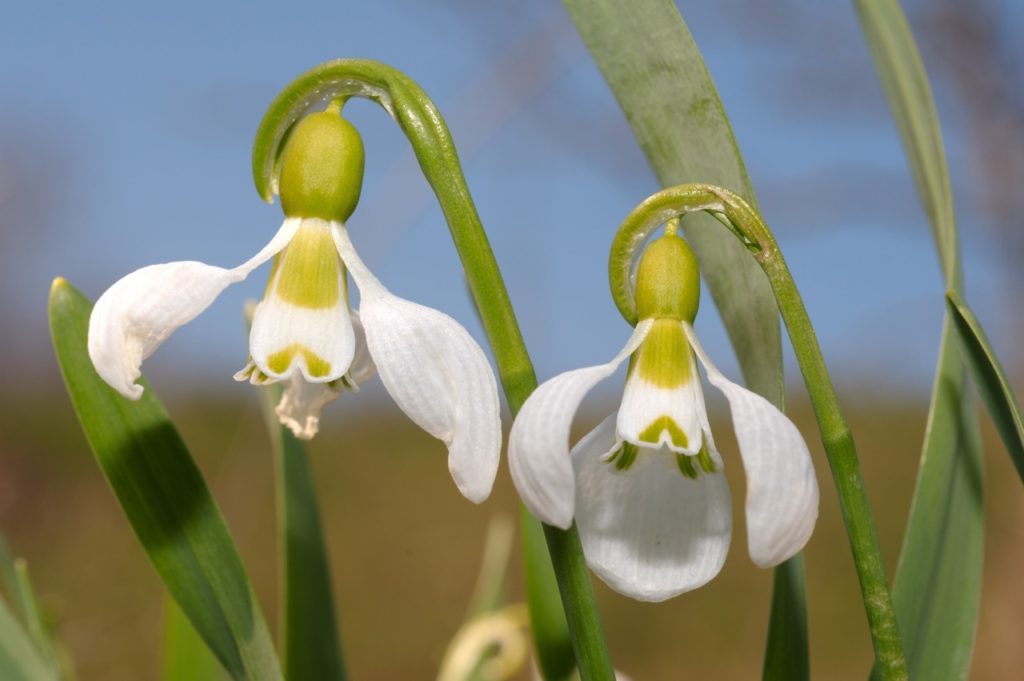
- COMMON NAME(S): greater snowdrop
- FLOWERING SEASON(S): winter
- SUNLIGHT: partial shade
- SIZE: 0.1-0.5m in height, 0-0.1m spread
The informal name for species type is the greater snowdrop, as this plant can grow between 25-30cm tall.
It features flowers that are just a little bigger than other snowdrops that also have green markings like an inverted ‘U’ at its petals’ tips and at the bases.
Flowers often settle at a perfect half-closed, half-open form.
It is among the earliest to come into bloom and varieties of this have received the RHS Award of Garden Merit.
14) G. elwesii ‘Mary Biddulph’
- COMMON NAME(S): greater snowdrop ‘mary biddulph’
- FLOWERING SEASON(S): winter
- SUNLIGHT: partial shade
- SIZE: 0.1-0.5m in height, 0-0.1m spread
‘Mary Biddulph’ is similar to the species with a couple of special twists.
The half-open pendent flowers have a shield over them in the form of a prominent curved bract.
In addition to this, the inner tepals have conspicuous green smudges that are often connected by narrow lines, as if they have been etched on.
15) G. elwesii ‘Ransom’s Dwarf’
- COMMON NAME(S): greater snowdrop ‘ransom’s dwarf’
- FLOWERING SEASON(S): winter
- SUNLIGHT: full sun / partial shade
- SIZE: 0.1-0.5m in height, 0-0.1m spread
At only about 15cm tall, ‘Ransom’s Dwarf’ is a short variety that still produces fairly large flowers.
With blooms that look a little too big for the plant, the overall effect is cute and humorous.
This cultivar’s inner tepals are prominently blotched in green at the bases and tips.
16) G. elwesii (Hiemalis Group)
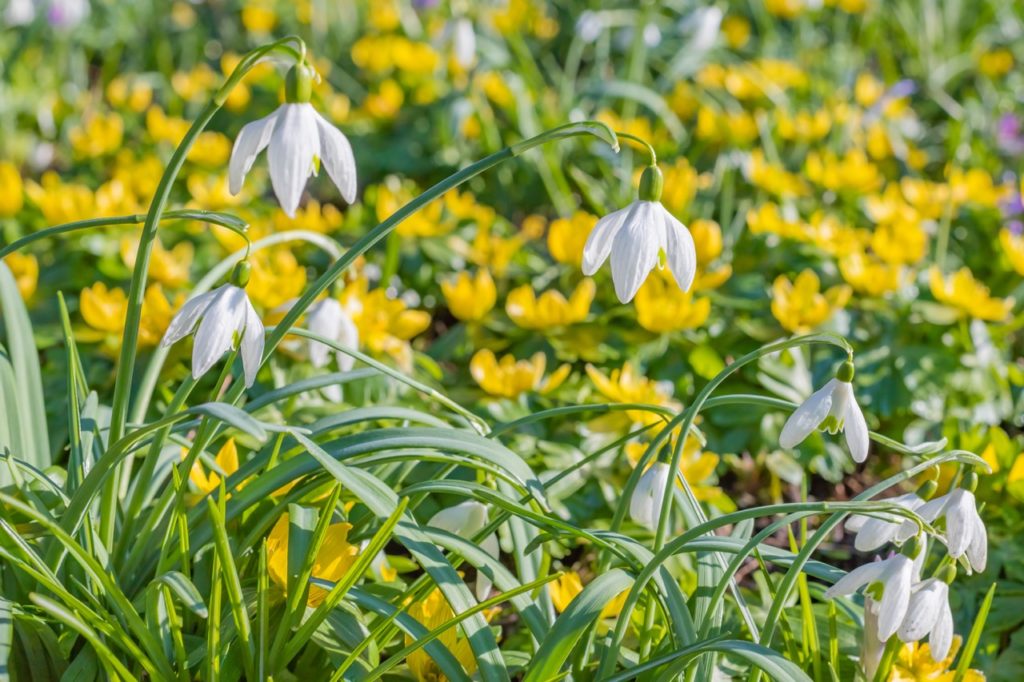
- COMMON NAME(S): greater snowdrop hiemalis group
- FLOWERING SEASON(S): autumn / winter
- SUNLIGHT: full sun / partial shade
- SIZE: 0.1-0.5m in height, 0.1-0.5m spread
Very special in yet another way, the ‘Hiemalis Group’ features standard snowdrop flowers with green blotches at the tips of the inner tepals.
What distinguishes this group of cultivars is that they are among the earliest to bloom and can produce flowers as early as November, ending its blooming season before the arrival of spring.
17) G. elwesii ‘Polar Bear’
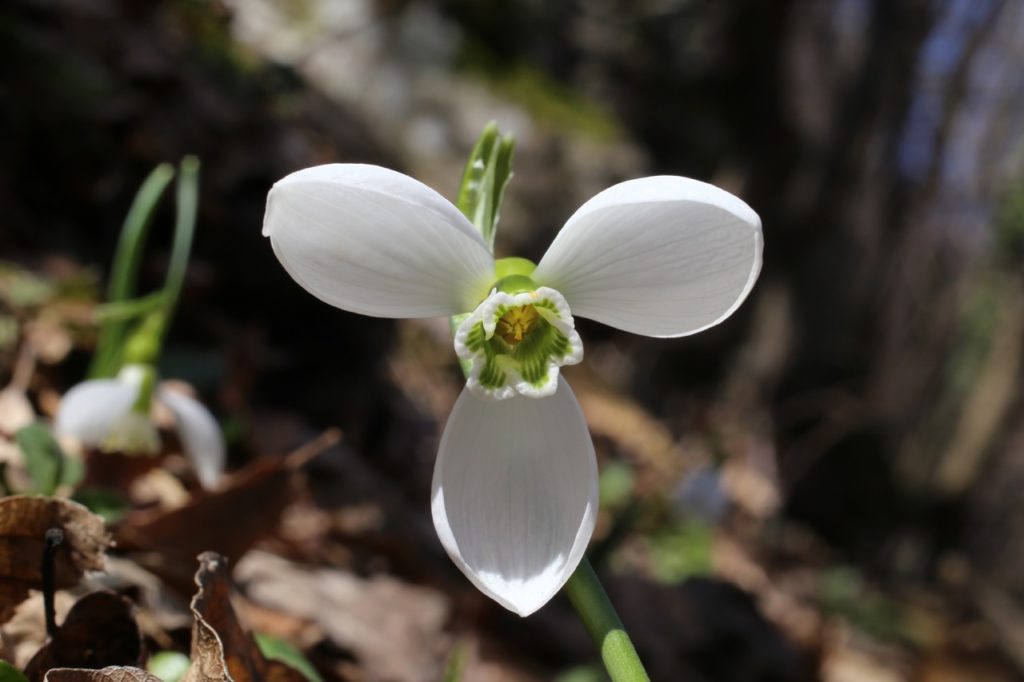
- COMMON NAME(S): greater snowdrop ‘polar bear’
- FLOWERING SEASON(S): spring
- SUNLIGHT: full sun / partial shade
- SIZE: 0.1-0.5m in height, 0.1-0.5m spread
Not easy to find, ‘Polar Bear’ is actually a double play in rare attributes among Snowdrops.
Firstly, its flowers face upward, and secondly, the outer tepals are wide open.
As a result, its flowers look like little propellors, except they are directed upwards.
The inner tepals are virtually half green, which is of a deep shade.
References
- 1Snowdrop. (n.d.). PlantAtlas. Retrieved March 16, 2023, from https://plantatlas2020.org/atlas/2cd4p9h.ymh

